Get free scan and check if your device is infected.
Remove it nowTo use full-featured product, you have to purchase a license for Combo Cleaner. Seven days free trial available. Combo Cleaner is owned and operated by RCS LT, the parent company of PCRisk.com.
What is "SharePoint" email scam?
Generally, scammers behind phishing emails fraudulently attempt to obtain sensitive information such as usernames, passwords and other credentials, and credit card details, by disguising their emails as messages from legitimate companies, organizations, etc.
This particular email is disguised as a message from SharePoint and the scammers behind it attempt to steal Microsoft 365 accounts.
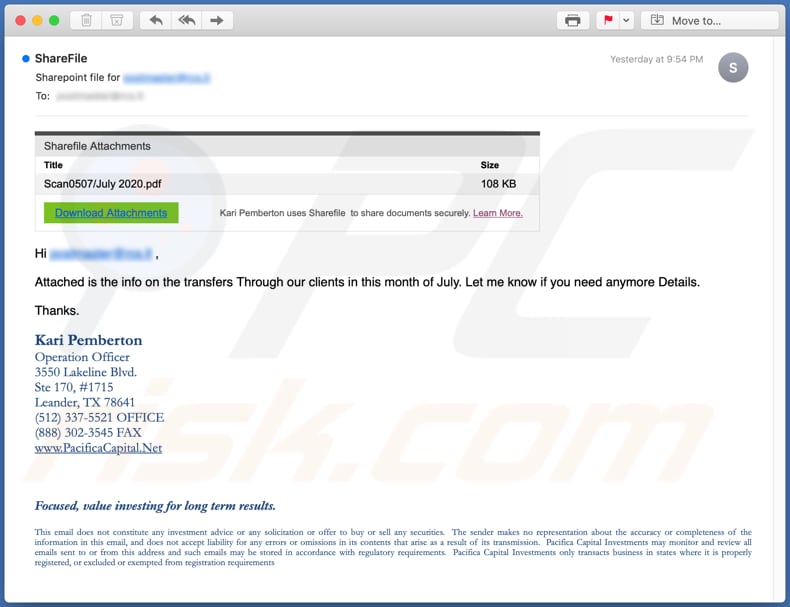
More about the "SharePoint" email scam
Research shows that scammers behind this phishing email target companies. They often use recipients' company names to make the email appear as it is was received from their employers. The main goal of the scammers is to trick recipients into clicking the hyperlink and following further instructions on the opened website.
The website asks recipients to click a button to download documents, however, the button downloads a PDF file (which contains a link to another website) or simply opens a submission form on which recipients are asked to enter their Microsoft (Office) 365 login credentials.
In summary, the main goal of scammers behind this email is steal the aforementioned credentials, which then gives them full control of the Microsoft 365 accounts. Scammers can misuse hijacked accounts to steal identities, spread this and other phishing emails, steal more information from the compromised organization, etc.
To avoid serious issues, you are strongly advised not to click links in emails of this kind. Do not download files that are attached to them or enter any login credentials on unofficial websites.
| Name | SharePoint Email Scam |
| Threat Type | Phishing, Scam, Social Engineering, Fraud. |
| Fake Claim | This email is disguised as a message regarding some "important documents". |
| Disguise | This phishing email is often disguised as an email from the recipient's company. |
| Symptoms | Unauthorized online purchases, changed online account passwords, identity theft, illegal access of the computer. |
| Distribution methods | Deceptive emails, rogue online pop-up ads, search engine poisoning techniques, misspelled domains. |
| Damage | Loss of sensitive private information, monetary loss, identity theft. |
| Malware Removal (Windows) |
To eliminate possible malware infections, scan your computer with legitimate antivirus software. Our security researchers recommend using Combo Cleaner. Download Combo CleanerTo use full-featured product, you have to purchase a license for Combo Cleaner. 7 days free trial available. Combo Cleaner is owned and operated by RCS LT, the parent company of PCRisk.com. |
Similar scams in general
In summary, phishing emails are usually disguised as official, urgent, important, etc. Commonly, they are also disguised as messages from legitimate entities. Note that emails can be used for phishing purposes and to distribute malicious software. For example, Trojans, ransomware, cryptocurrency miners, and other malware.
Some examples of other phishing emails are "Server Notification Email Scam", "GitHub Email Scam" and "ShareFile Attachment Email Scam".
How do spam campaigns infect computers?
Typically, cyber criminals behind malspam campaigns send emails with a file attached to them or a download link to the malicious file. Their main goal is to trick recipients into opening/executing the rogue file, which then installs malicious software.
Some examples of files that cyber criminals send via email are Microsoft Office and PDF documents, executables (.exe), JavaScript, and archives (ZIP, RAR). Note that malicious documents that are opened with Microsoft Office 2010 or newer versions install malicious software only if users enable macros commands (enable editing/content).
These versions include "Protected View" mode, which does not allow opened malicious documents to install malware automatically. Older versions do not include this feature and install malicious software without asking permission.
How to avoid installation of malware
To avoid infecting the system with malware spread through spam mail, you are strongly advised not to open suspicious or irrelevant emails, especially those with any attachments or links present in them. Use official and verified download channels.
Additionally, all programs must be activated and updated with tools/functions provided by legitimate developers, since illegal activation tools ("cracks") and third party updaters commonly proliferate malicious software. To ensure device integrity and user safety, it is paramount to have reputable anti-virus/anti-spyware installed and kept updated.
Furthermore, use these programs to run regular system scans and to remove detected/potential threats. If you have already opened malicious attachments, we recommend running a scan with Combo Cleaner Antivirus for Windows to automatically eliminate infiltrated malware.
Text presented in the "SharePoint Email Scam" email message:
Subject: Sharepoint file for -
Sharefile Attachments
Title Size
Scan0507/July 2020.pdf 108 KB
Download Attachments Kari Pemberton uses Sharefile to share documents securely. Learn More.
Hi - ,
Attached is the info on the transfers Through our clients in this month of July. Let me know if you need anymore Details.
Thanks.
Kari Pemberton
Operation Officer
3550 Lakeline Blvd.
Ste 170, #1715
Leander, TX 78641
(512) 337-5521 OFFICE
(888) 302-3545 FAX
www.PacificaCapital.Net
Focused, value investing for long term results.
This email does not constitute any investment advice or any solicitation or offer to buy or sell any securities. The sender makes no representation about the accuracy or completeness of the information in this email, and does not accept liability for any errors or omissions in its contents that arise as a result of its transmission. Pacifica Capital Investments may monitor and review all emails sent to or from this address and such emails may be stored in accordance with regulatory requirements. Pacifica Capital Investments only transacts business in states where it is properly registered, or excluded or exempted from registration requirements
Screenshot of the second variant of this phishing email:
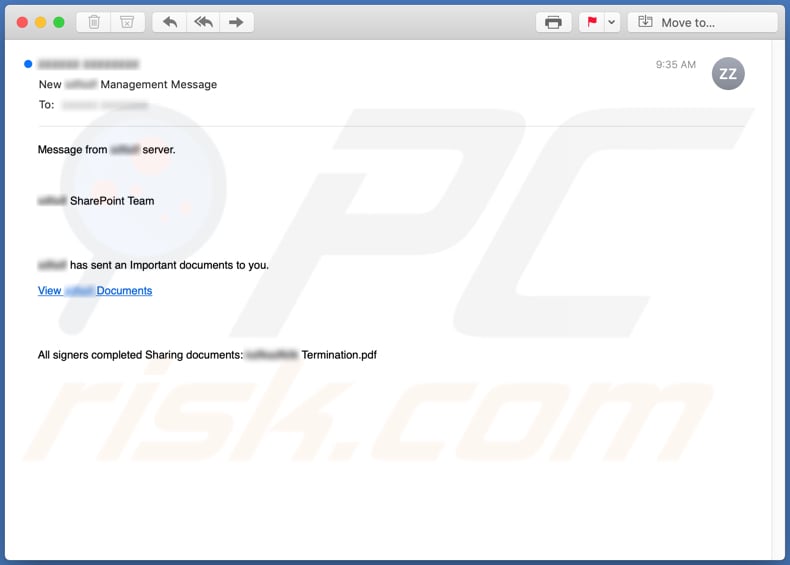
Text in this email:
Subject: New - Management Message
Message from - server.
- SharePoint Team
- has sent an Important documents to you.
View - Documents
All signers completed Sharing documents: - Termination.pdf
An example of SharePoint-themed spam email used to promote a phishing website:
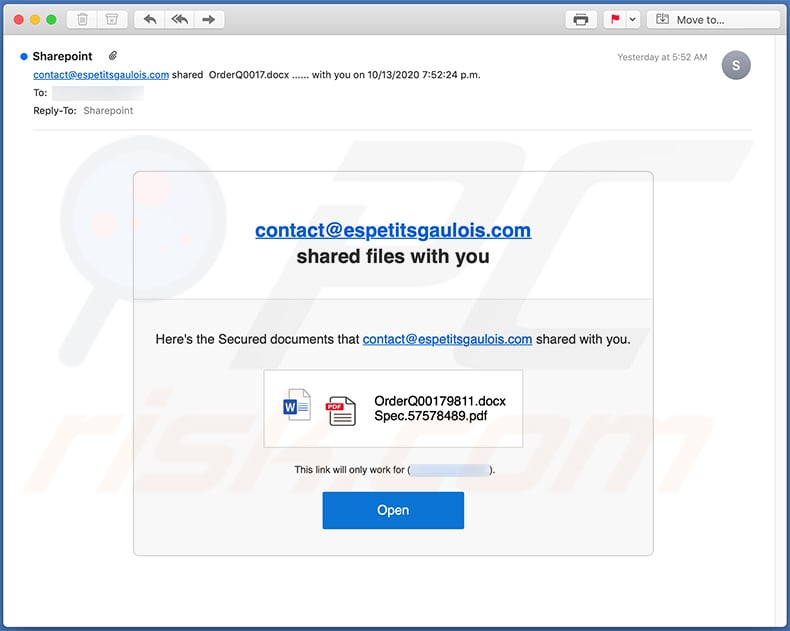
Text presented within:
Subject: contact@espetitsgaulois.com shared OrderQ0017.docx ...... with you on 10/13/2020 7:52:24 p.m.
contact@espetitsgaulois.com shared files with you
Here's the Secured documents that contact@espetitsgaulois.com shared with you.
OrderQ00179811.docx
Spec.57578489.pdf
This link will only work for (-).
Open
Screenshot of the promoted phishing site (fake SharePoint login site):
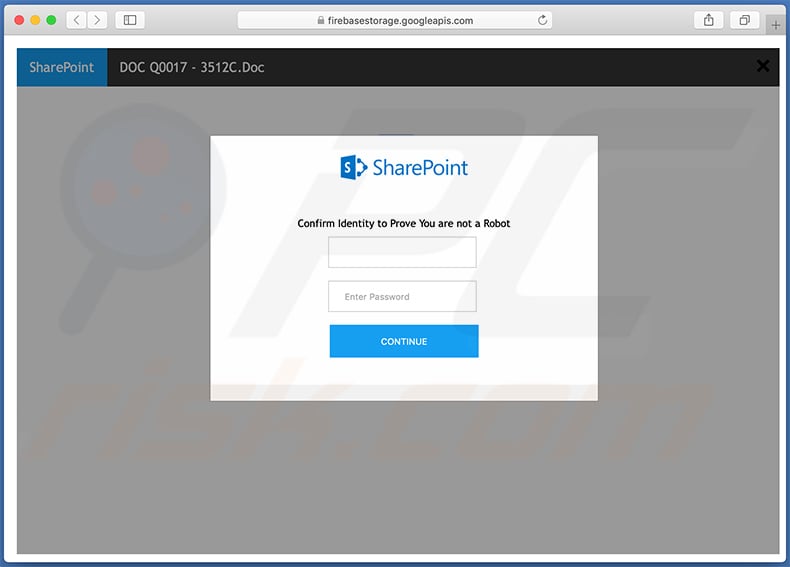
Yet another SharePoint-themed spam email used to promote a phishing website (fake WebMail login site):
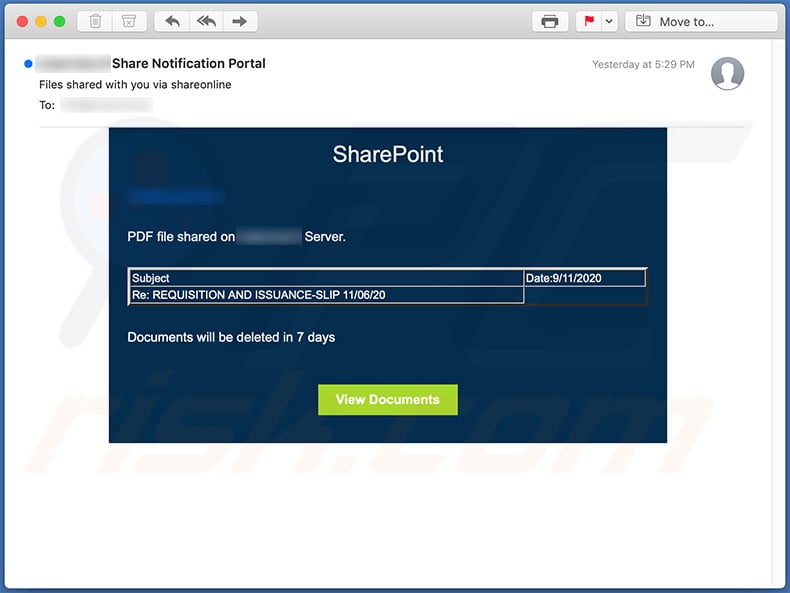
Text presented:
Subject: Files shared with you via shareonline
SharePoint
********
PDF file shared on ******** Server.
Date:9/11/2020
Re: REQUISITION AND ISSUANCE-SLIP 11/06/20Documents will be deleted in 7 days
View Documents
Screenshot of the promoted website (kitestcon.web[.]app):
![Fake Webmail login site (kitestcon.web[.]app) promoted via SharePoint-themed spam email](/images/stories/screenshots202011/sharepoint-update-2020-11-10-fake-website.jpg)
Yet another SharePoint-themed spam email used to promote a phishing website:
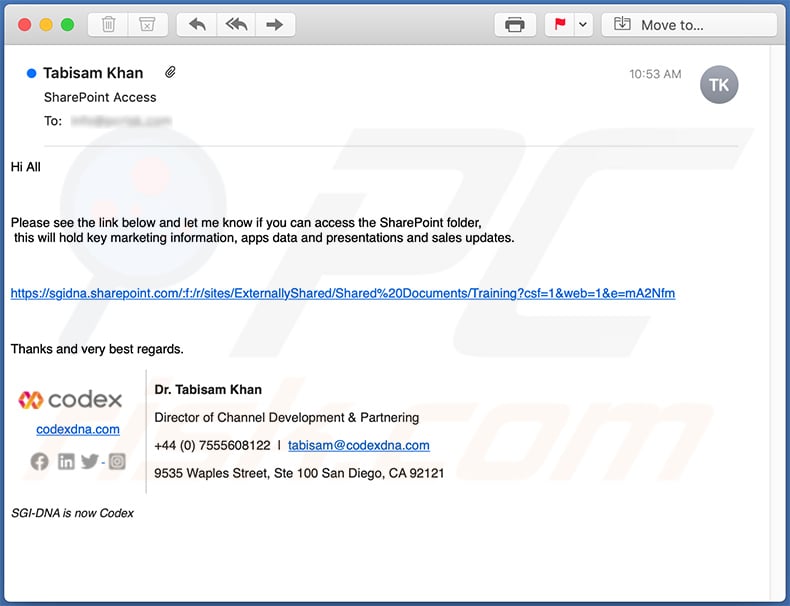
Text presented within:
Subject: SharePoint Access
Hi All
Please see the link below and let me know if you can access the SharePoint folder,
this will hold key marketing information, apps data and presentations and sales updates.hxxps://sgidna.sharepoint.com/:f:/r/sites/ExternallyShared/Shared%20Documents/Training?csf=1&web=1&e=mA2Nfm
Thanks and very best regards.
codexdna.com
Dr. Tabisam KhanDirector of Channel Development & Partnering
+44 (0) 7555608122 | tabisam@codexdna.com
9535 Waples Street, Ste 100 San Diego, CA 92121
SGI-DNA is now Codex
Appearance of the promoted phishing website (GIF):
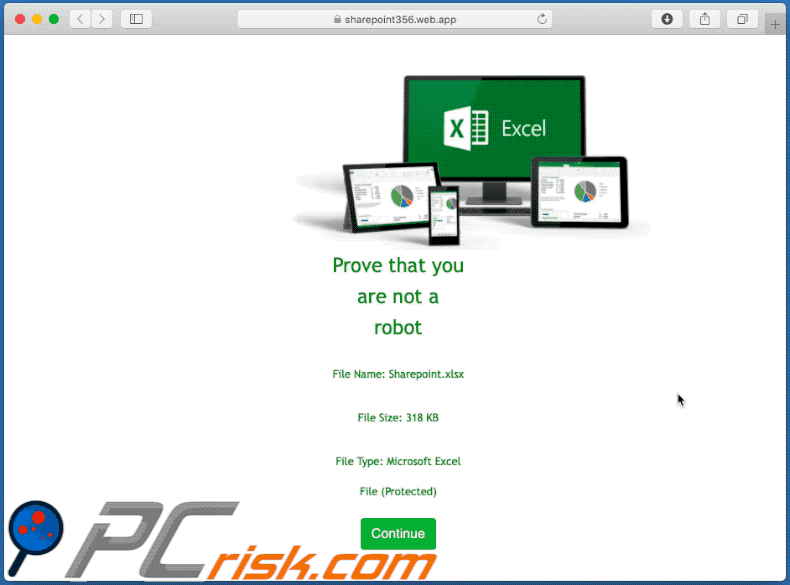
Another example of SharePoint-themed spam email promoting a phishing website:
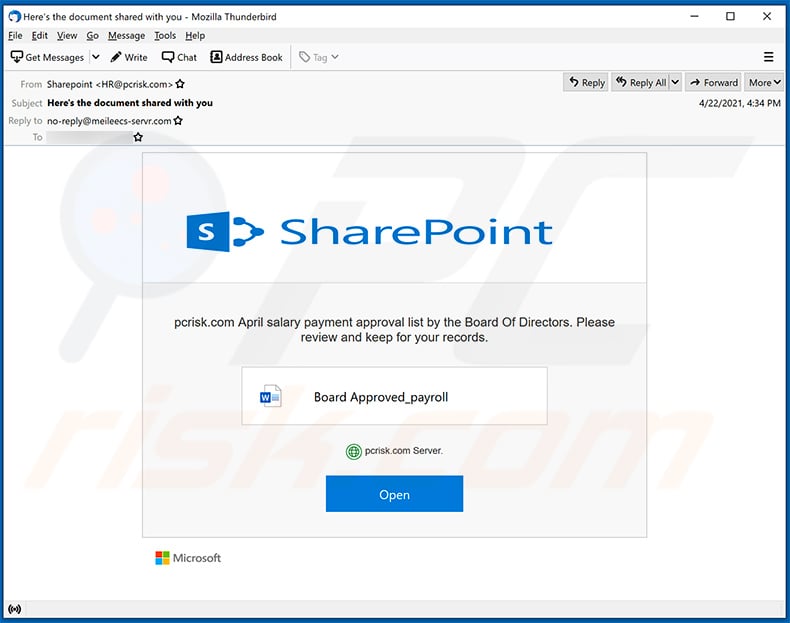
Text presented within:
Subject: Here's the document shared with you
******** April salary payment approval list by the Board Of Directors. Please review and keep for your records.
Board Approved_payroll
******** Server.
Open
Screenshot of the promoted phishing website:
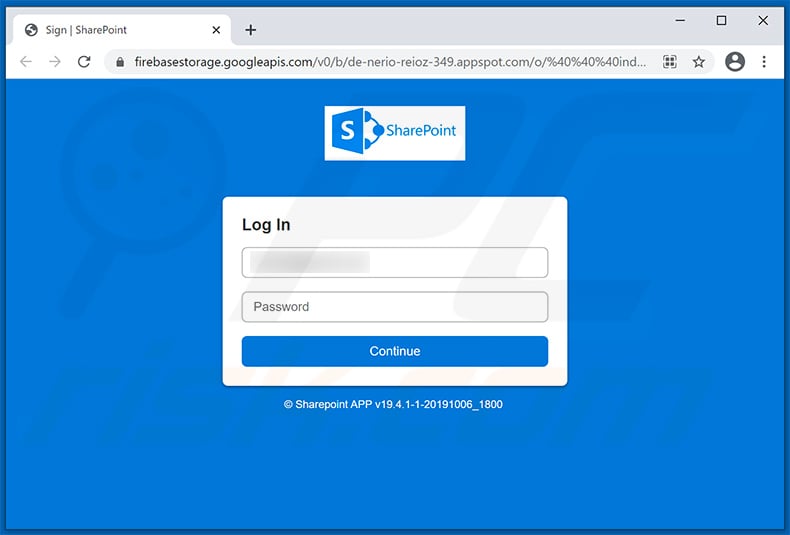
Yet another example of SharePoint-themed spam email promoting a phishing site:
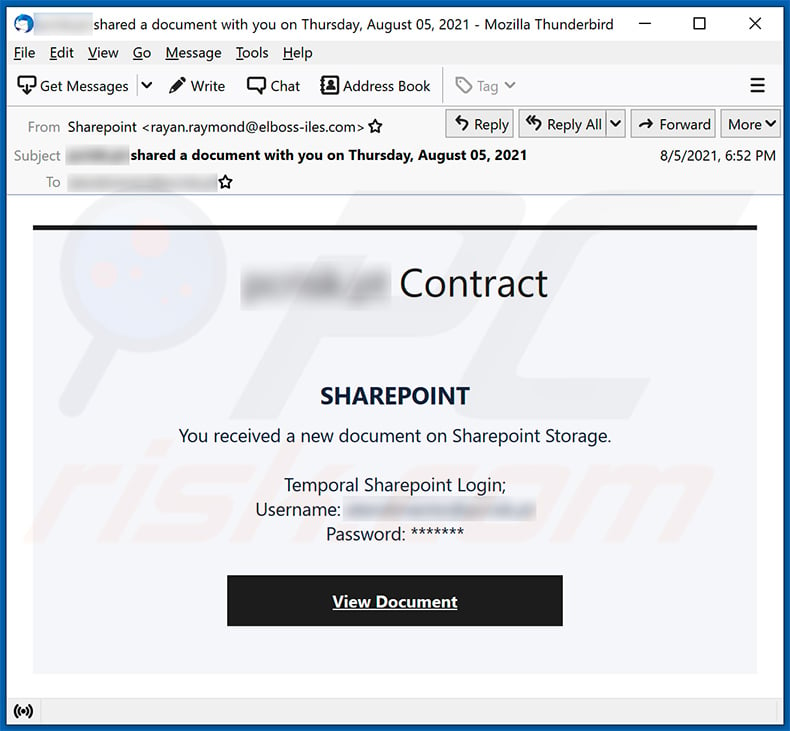
Text presented within:
Subject: ******** shared a document with you on Thursday, August 05, 2021
******** Contract
SHAREPOINTYou received a new document on SharePoint Storage.
Temporal Sharepoint Login;
Username: ********
Password: *******
View Document
Screenshot of the promoted phishing website:
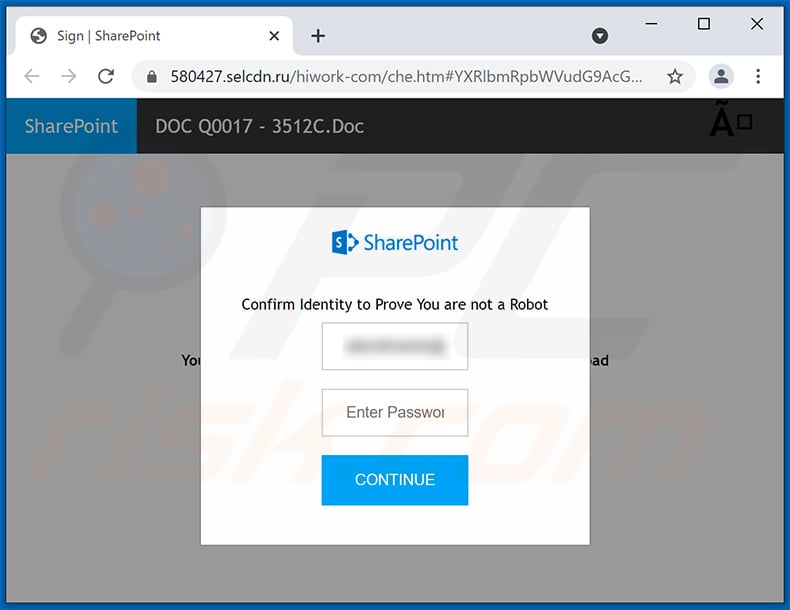
Yet another example of SharePoint-themed spam email promoting a phishing site:
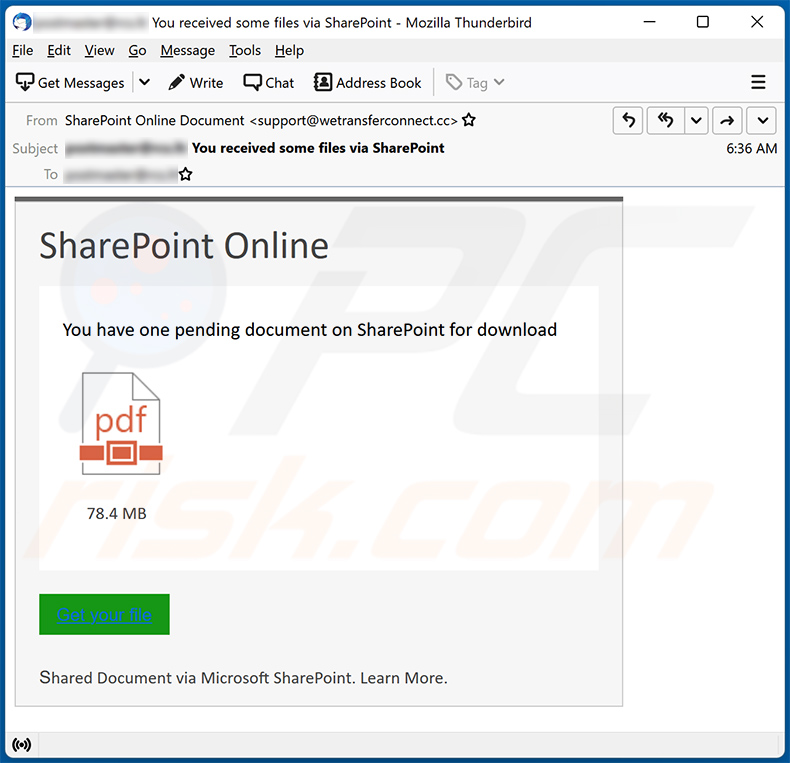
Text presented within:
Subject: - You received some files via SharePoint
SharePoint Online
You have one pending document on SharePoint for download
78.4 MB
Get your fileShared Document via Microsoft SharePoint. Learn More.
Yet another example of SharePoint-themed spam email promoting a phishing site:
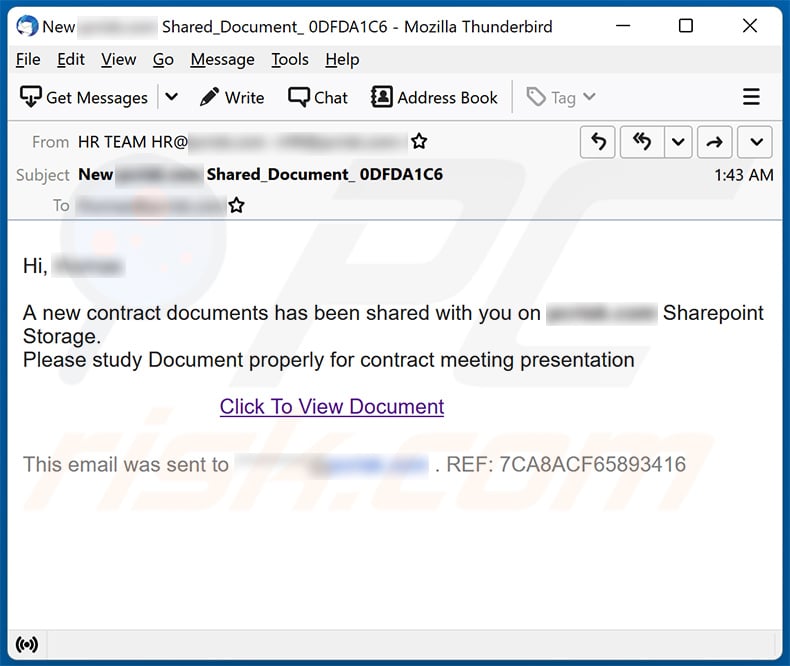
Text presented within:
Subject:
Hi, -
A new contract documents has been shared with you on pcrisk.com Sharepoint Storage.
Please study Document properly for contract meeting presentationClick To View Document
This email was sent to - . REF: 7CA8ACF65893416
Another example of SharePoint-themed spam email promoting a phishing site:
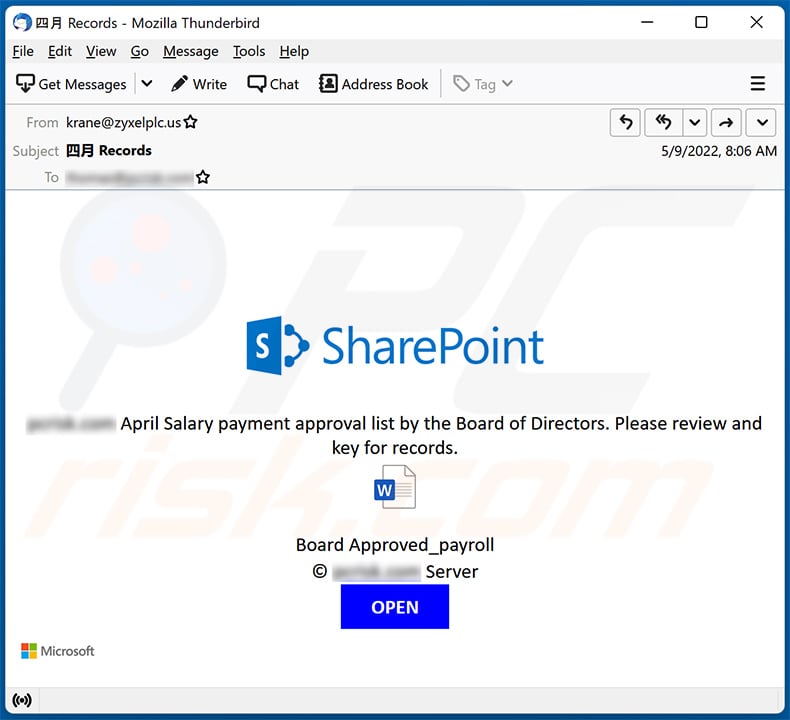
Text presented within:
Subject: 四月 Records
SharePoint- April Salary payment approval list by the Board of Directors. Please review and key for records.
Board Approved_payroll
© - Server
OPEN
Screenshot of the promoted phishing site:
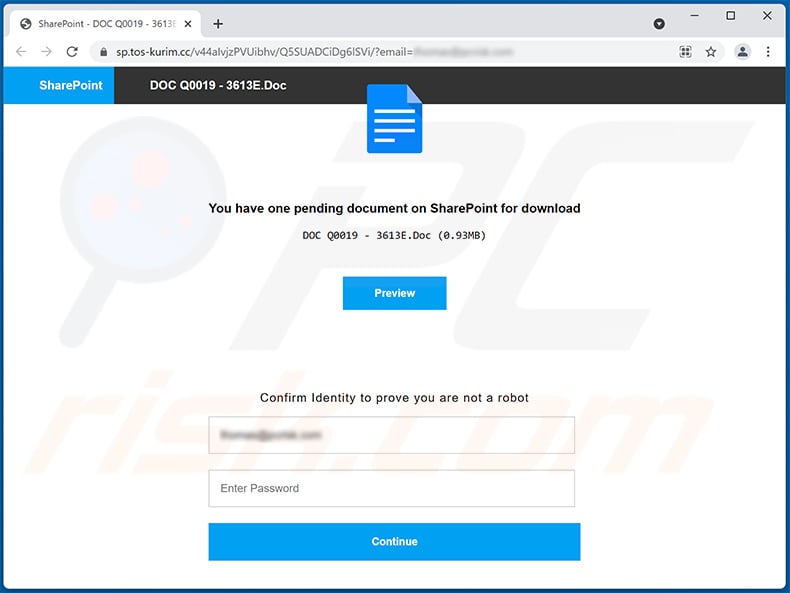
Yet another example of SharePoint-themed spam email used to promote a phishing site:
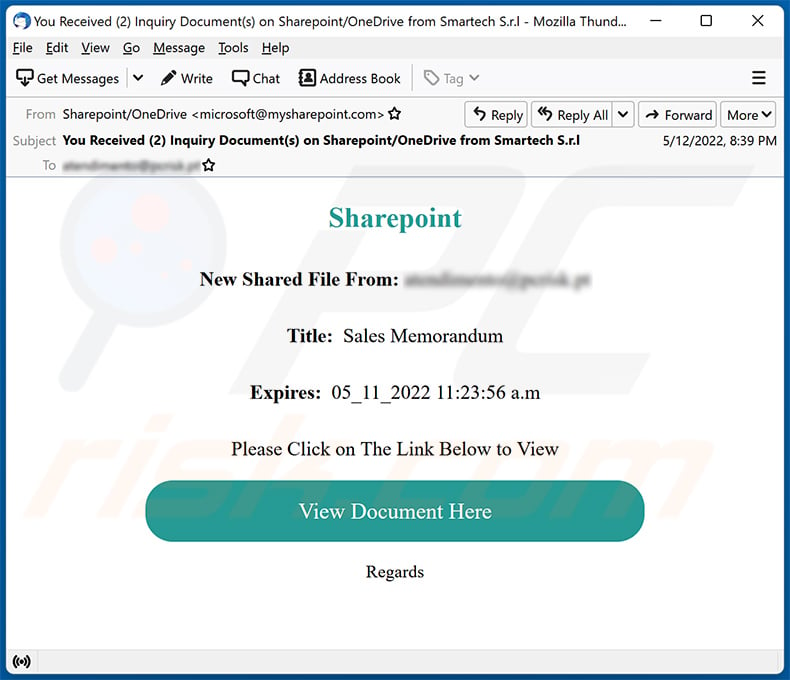
Text presented within:
Subject: You Received (2) Inquiry Document(s) on Sharepoint/OneDrive from Smartech S.r.l
Sharepoint
New Shared File From: -
Title: Sales Memorandum
Expires: 05_11_2022 11:23:56 a.m
Please Click on The Link Below to View
View Document Here
Regards
Screenshot of the promoted phishing site:
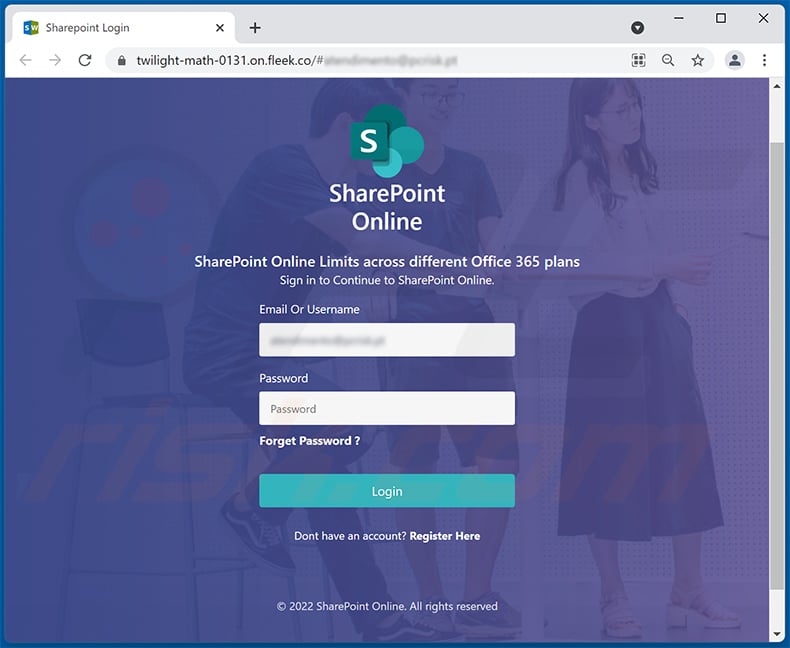
Another example of SharePoint-themed spam email promoting a phishing site:
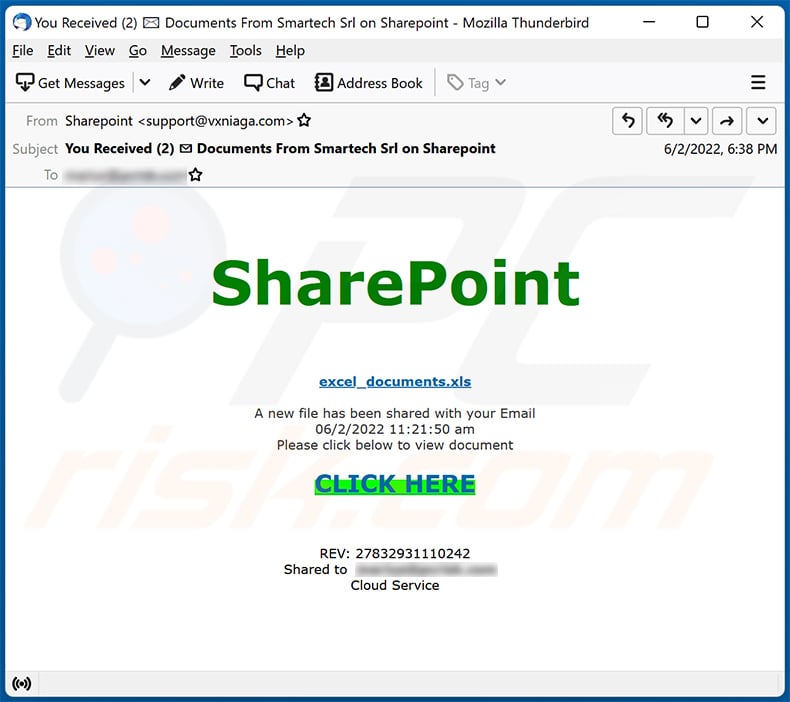
Text presented within:
Subject: You Received (2) Documents From Smartech Srl on Sharepoint
SharePoint
excel_documents.xls
A new file has been shared with your Email
06/2/2022 11:21:50 am
Please click below to view documentCLICK HERE
REV: 27832931110242
Shared to -
Cloud Service
Screenshot of the promoted phishing site:
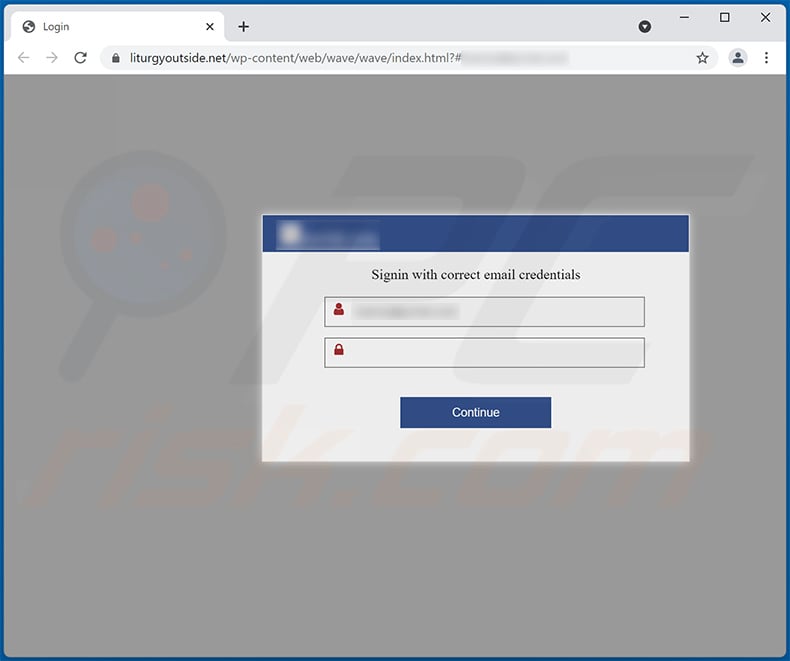
Another example of SharePoint-themed spam email promoting a phishing site:
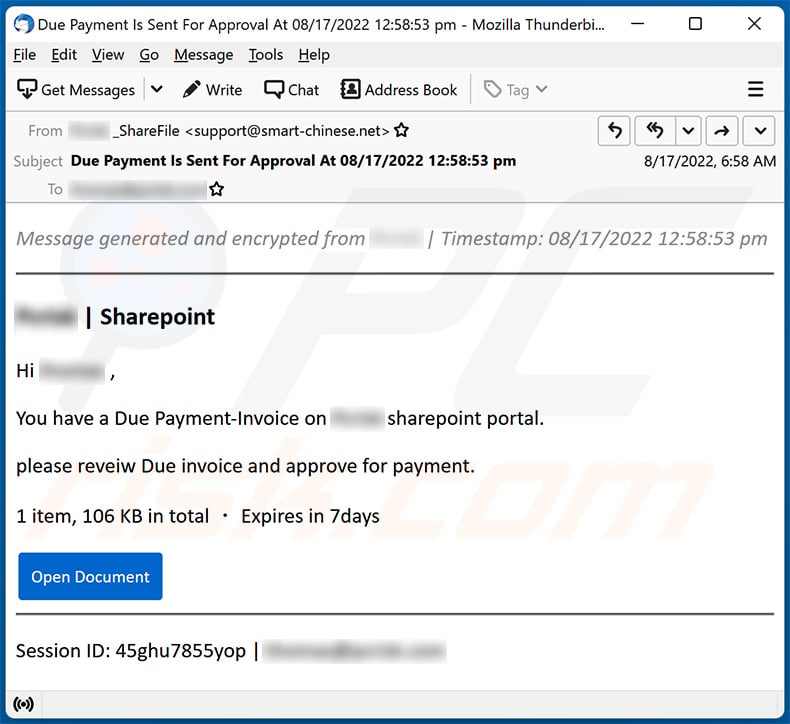
Text presented within:
Subject: Due Payment Is Sent For Approval At 08/17/2022 12:58:53 pm
Message generated and encrypted from ********** | Timestamp: 08/17/2022 12:58:53 pm
********** | SharepointHi ********** ,
You have a Due Payment-Invoice on ********** sharepoint portal.
please reveiw Due invoice and approve for payment.
1 item, 106 KB in total ・ Expires in 7days
Open DocumentSession ID: 45ghu7855yop | **********
Screenshot of the promoted phishing site:
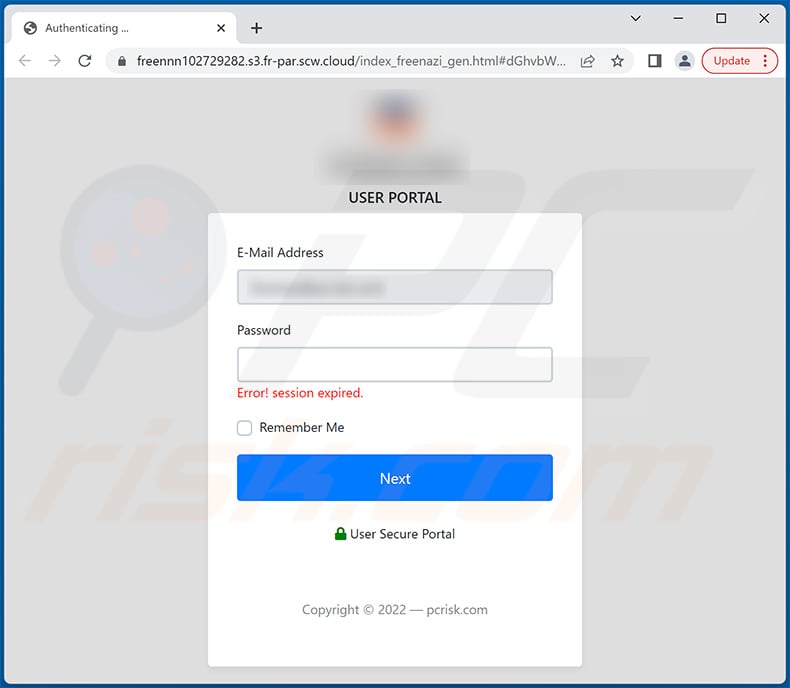
Another example of SharePoint-themed spam email promoting a phishing site:
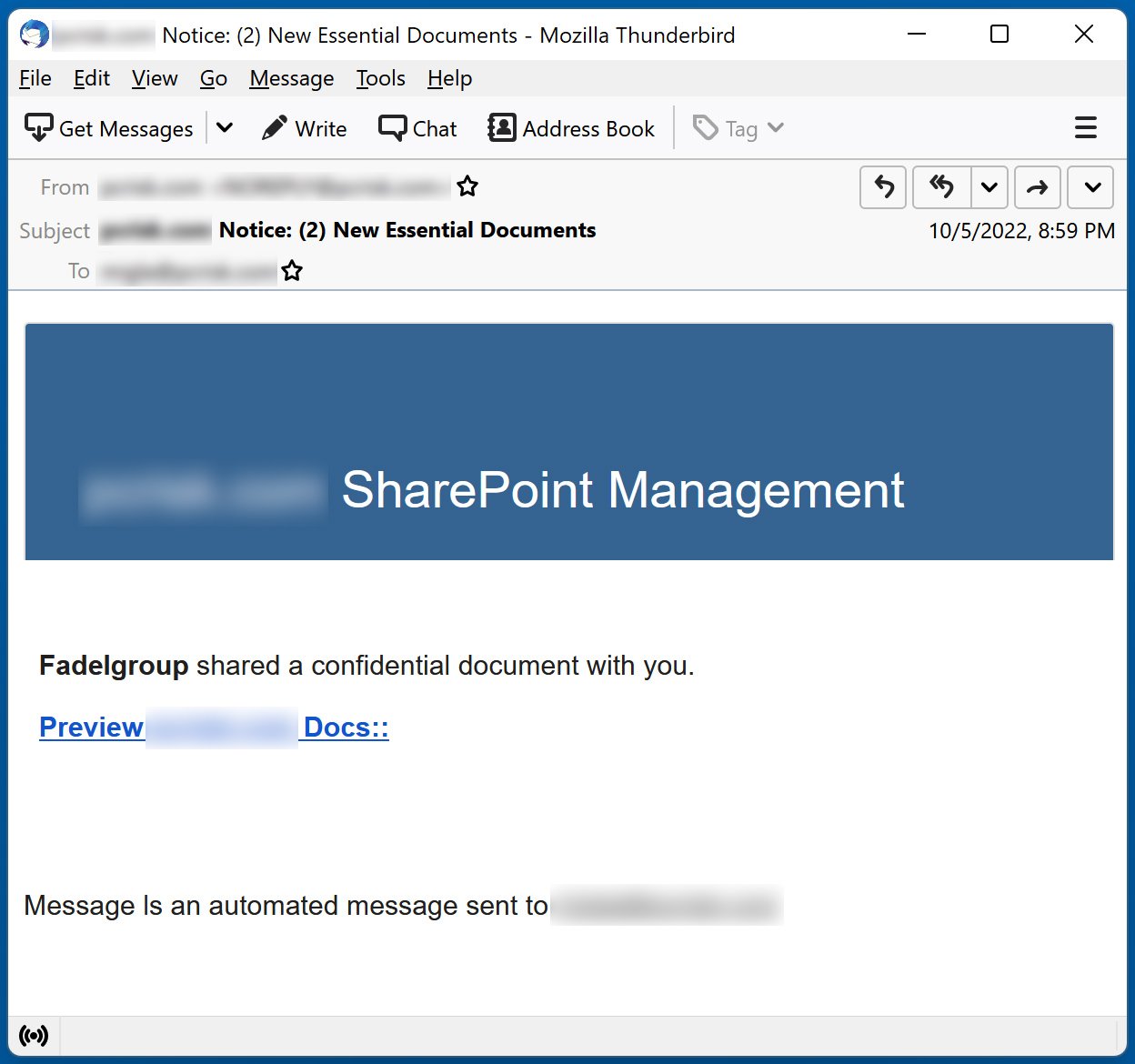
Text presented within:
Subject: - Notice: (2) New Essential Documents
- SharePoint ManagementFadelgroup shared a confidential document with you.
Preview - Docs::
Message ls an automated message sent to -
Another SharePoint-themed spam email example:
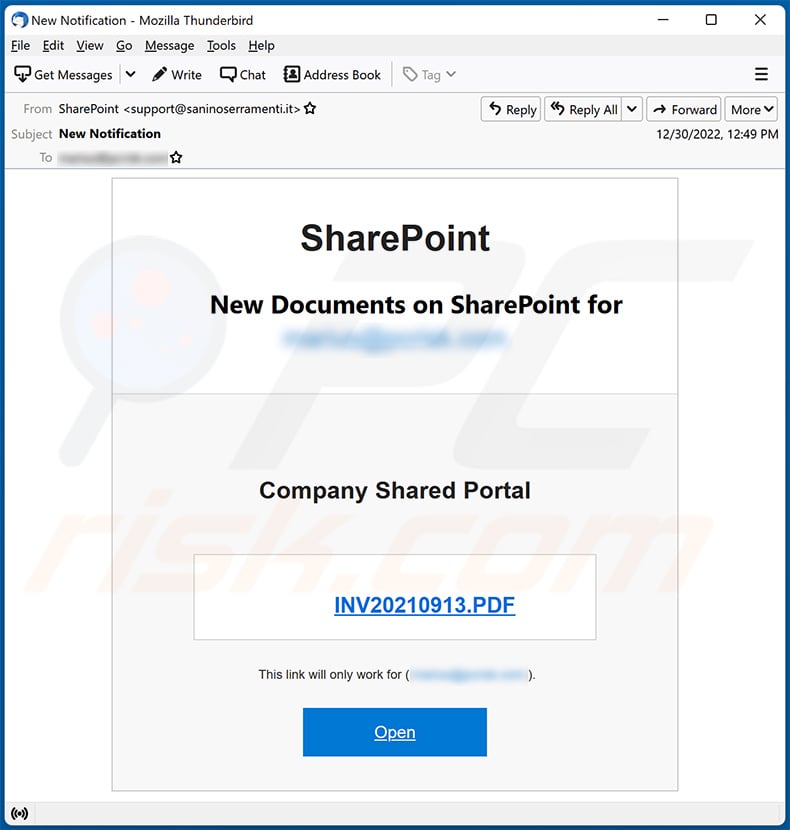
Text presented within:
Subject: New Notification
SharePoint
New Documents on SharePoint for*********
Company Shared Portal
INV20210913.PDF
This link will only work for ( ********* ).
Open
Instant automatic malware removal:
Manual threat removal might be a lengthy and complicated process that requires advanced IT skills. Combo Cleaner is a professional automatic malware removal tool that is recommended to get rid of malware. Download it by clicking the button below:
DOWNLOAD Combo CleanerBy downloading any software listed on this website you agree to our Privacy Policy and Terms of Use. To use full-featured product, you have to purchase a license for Combo Cleaner. 7 days free trial available. Combo Cleaner is owned and operated by RCS LT, the parent company of PCRisk.com.
Quick menu:
- What is SharePoint spam?
- Types of malicious emails.
- How to spot a malicious email?
- What to do if you fell for an email scam?
Types of malicious emails:
![]() Phishing Emails
Phishing Emails
Most commonly, cybercriminals use deceptive emails to trick Internet users into giving away their sensitive private information, for example, login information for various online services, email accounts, or online banking information.
Such attacks are called phishing. In a phishing attack, cybercriminals usually send an email message with some popular service logo (for example, Microsoft, DHL, Amazon, Netflix), create urgency (wrong shipping address, expired password, etc.), and place a link which they hope their potential victims will click on.
After clicking the link presented in such email message, victims are redirected to a fake website that looks identical or extremely similar to the original one. Victims are then asked to enter their password, credit card details, or some other information that gets stolen by cybercriminals.
![]() Emails with Malicious Attachments
Emails with Malicious Attachments
Another popular attack vector is email spam with malicious attachments that infect users' computers with malware. Malicious attachments usually carry trojans that are capable of stealing passwords, banking information, and other sensitive information.
In such attacks, cybercriminals' main goal is to trick their potential victims into opening an infected email attachment. To achieve this goal, email messages usually talk about recently received invoices, faxes, or voice messages.
If a potential victim falls for the lure and opens the attachment, their computers get infected, and cybercriminals can collect a lot of sensitive information.
While it's a more complicated method to steal personal information (spam filters and antivirus programs usually detect such attempts), if successful, cybercriminals can get a much wider array of data and can collect information for a long period of time.
![]() Sextortion Emails
Sextortion Emails
This is a type of phishing. In this case, users receive an email claiming that a cybercriminal could access the webcam of the potential victim and has a video recording of one's masturbation.
To get rid of the video, victims are asked to pay a ransom (usually using Bitcoin or another cryptocurrency). Nevertheless, all of these claims are false - users who receive such emails should ignore and delete them.
How to spot a malicious email?
While cyber criminals try to make their lure emails look trustworthy, here are some things that you should look for when trying to spot a phishing email:
- Check the sender's ("from") email address: Hover your mouse over the "from" address and check if it's legitimate. For example, if you received an email from Microsoft, be sure to check if the email address is @microsoft.com and not something suspicious like @m1crosoft.com, @microsfot.com, @account-security-noreply.com, etc.
- Check for generic greetings: If the greeting in the email is "Dear user", "Dear @youremail.com", "Dear valued customer", this should raise suspiciousness. Most commonly, companies call you by your name. Lack of this information could signal a phishing attempt.
- Check the links in the email: Hover your mouse over the link presented in the email, if the link that appears seems suspicious, don't click it. For example, if you received an email from Microsoft and the link in the email shows that it will go to firebasestorage.googleapis.com/v0... you shouldn't trust it. It's best not to click any links in the emails but to visit the company website that sent you the email in the first place.
- Don't blindly trust email attachments: Most commonly, legitimate companies will ask you to log in to their website and to view any documents there; if you received an email with an attachment, it's a good idea to scan it with an antivirus application. Infected email attachments are a common attack vector used by cybercriminals.
To minimise the risk of opening phishing and malicious emails we recommend using Combo Cleaner Antivirus for Windows.
Example of a spam email:

What to do if you fell for an email scam?
- If you clicked on a link in a phishing email and entered your password - be sure to change your password as soon as possible. Usually, cybercriminals collect stolen credentials and then sell them to other groups that use them for malicious purposes. If you change your password in a timely manner, there's a chance that criminals won't have enough time to do any damage.
- If you entered your credit card information - contact your bank as soon as possible and explain the situation. There's a good chance that you will need to cancel your compromised credit card and get a new one.
- If you see any signs of identity theft - you should immediately contact the Federal Trade Commission. This institution will collect information about your situation and create a personal recovery plan.
- If you opened a malicious attachment - your computer is probably infected, you should scan it with a reputable antivirus application. For this purpose, we recommend using Combo Cleaner Antivirus for Windows.
- Help other Internet users - report phishing emails to Anti-Phishing Working Group, FBI’s Internet Crime Complaint Center, National Fraud Information Center and U.S. Department of Justice.
Frequently Asked Questions (FAQ)
Why did I receive this email?
Usually, scammers use email addresses leaked after data breaches in their campaigns. They send the same email to all recipients (their emails are not personal).
I have provided my personal information when tricked by this email, what should I do?
If you have provided your password, change all passwords as soon as possible (especially if scammers can use the provided password and your email address to access more than one account).
I have downloaded and opened a malicious file attached to an email, is my computer infected?
It depends on the file type. For example, malicious Microsoft Office documents cannot infect computers unless macros commands are enabled after opening them. Most executable files (like .exe) infect computers right after they are opened/executed.
I have read the email but did not open the attachment, is my computer infected?
No, opening an email is harmless. Thus, your computer is not infected if you have not clicked any links or opened attachments.
Will Combo Cleaner remove malware infections that were present in email attachment?
Yes, Combo Cleaner can detect and remove almost all known malware. It is important to know that high-end malware can hide deep in the operating system. For this reason, it is required to run a full system scan to remove it.
Share:

Tomas Meskauskas
Expert security researcher, professional malware analyst
I am passionate about computer security and technology. I have an experience of over 10 years working in various companies related to computer technical issue solving and Internet security. I have been working as an author and editor for pcrisk.com since 2010. Follow me on Twitter and LinkedIn to stay informed about the latest online security threats.
PCrisk security portal is brought by a company RCS LT.
Joined forces of security researchers help educate computer users about the latest online security threats. More information about the company RCS LT.
Our malware removal guides are free. However, if you want to support us you can send us a donation.
DonatePCrisk security portal is brought by a company RCS LT.
Joined forces of security researchers help educate computer users about the latest online security threats. More information about the company RCS LT.
Our malware removal guides are free. However, if you want to support us you can send us a donation.
Donate
▼ Show Discussion